Welcome to our comprehensive guide featuring the top electrician websites, meticulously curated by our skilled team of web designers and developers. After rigorously evaluating hundreds of electrician websites, we’ve ranked them based on vital factors such as design, functionality, uniqueness, user experience, and other important grading elements.
Our aim is to provide electricians with a wealth of inspiration and ideas for their next website, ensuring an online presence that effectively showcases their expertise and captivates potential clients.
In this article, we’ll delve into the essential components of a successful electrician website, including user-friendly navigation, engaging visuals, informative service descriptions, client testimonials, and a seamless quote request process that caters to both residential and commercial customers. This isn’t our first similar article – if you stop by our best web designs article you’ll find a collection of thousands of amazing websites organized into dozens of different business industries.
Join us as we explore the realm of exceptional electrician web design, and learn how to create an online experience that distinguishes your business in the competitive electrical services market.
Top Electrician Website Designs
- 1. Faith Technologies
- 2. Suburban Enterprises
- 3. Pieper Power
- 4. Hi-Tech Electric
- 5. Oak Electric
- 6. Green Electrical
- 7. FA Electric
- 8. Daven Electric
- 9. Randy’s Electric
- 10. Electrician Techs
- 11. JLC Electrical Contractors
- 12. Blackmer Electric
- 13. Desanto Electric
- 14. CSI Electrical Contractors
- 15. Mr. Electric
- 16. High Class Electric
- 17. Clutch Electrical
- 18. Puckett Electric
- 19. 4th Generation Electric
- 20. Hall Electrical Ltd
- 21. All American Electric
- 22. Wilcox Electric
- 23. Bailey & Shipp Electric
- 24. Haas & Sons Electric
- 25. Magothy Electric Co.
- 26. Clinton Electric Co.
- 27. Benchmark Electric Co
- 28. John Goudie Electrical Contractor
- 29. Nipper Electric
- 30. Contract Electrical
- 31. 5 Points Electrical
- 32. Cline Electrical
- 33. Melbourne Wiring Services
- 34. Clark Electric
- 35. Gibbs Electric Company
- 36. Coastal Electric of Georgia
- 37. Belleville Electric
- 38. Bowen Electric
- 39. Tactical Power Services
- 40. NuBlue
- 41. T&D Electrical
- 42. Mister Sparky
- 43. Ridgeline Electric LLC
- 44. Davis Electric
- 45. Vancity Electrician
- 46. Willxon Electric Inc
- 47. Sunrise Electric
- 48. Wes Carver Electric
1. Faith Technologies
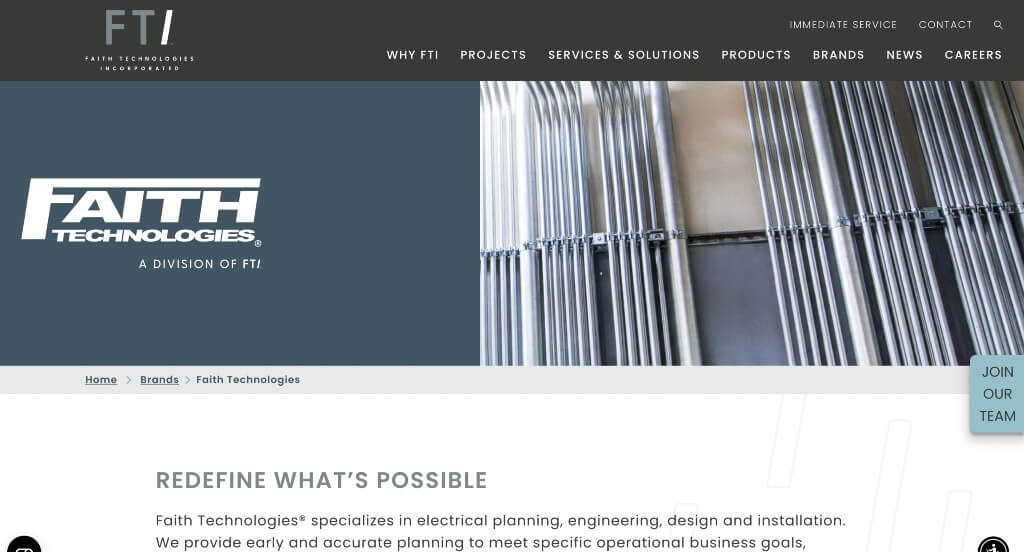
The white, red and gray colors used in this custom electrician website stood out to us because it created a professional design that wasn’t distracting. As you scroll through the homepage of the website, one of the qualities you’ll notice right away is their imagery used as a background. The page dedicated to their past projects was definitely refreshing for a unique site. Faith Technologies clearly had digital marketing in mind when designing the domain for their website that matches their company’s name. Be sure to consider the creative design of this finance website when developing your next custom website.
2. Suburban Enterprises

This is a great website example for electricians who are looking for a custom site layout. The orange and yellow accent colors were probably the most impactful quality in the homepage of this website. The customer review section was a good choice for a unique site. They clearly had a focus on digital marketing when building the icons used in their website. If you are looking for template examples for your next electrician website, be sure to check this one out.
3. Pieper Power
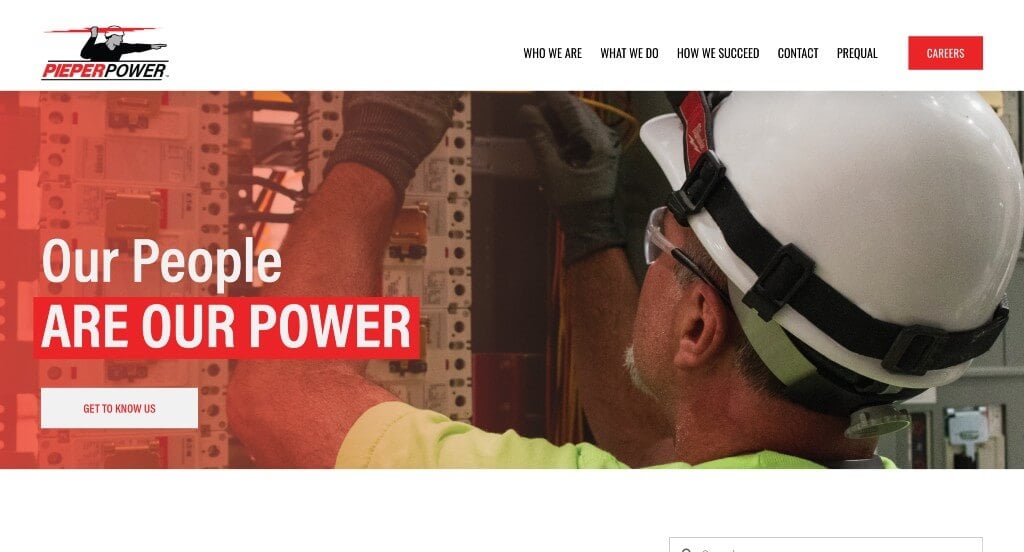
The red, black and white colors seen in this custom electrician website stood out to us because the contrast of the colors creates a unique touch. After scrolling past the header of this electrician site, you’ll immediately notice some high quality visuals. Another thoughtful quality in this professional electrician website was the added textures for their backgrounds. They clearly had conversions in mind when creating the interesting logo design for their company of their website. For electricians looking for examples for their next website layout, this example will for sure be one to consider.
4. Hi-Tech Electric
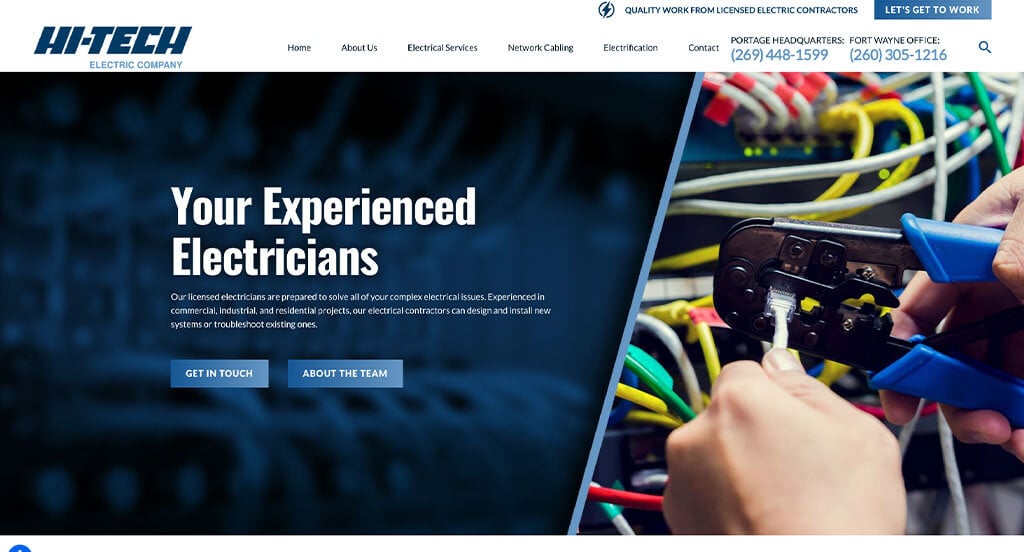
This is a good example of a website design for an electrician who is searching for a professional website design idea. The bold fonts for titles was definitely the most impactful feature in the homepage of this website. Another thoughtful feature of this custom electrician website was the royal blue color used throughout the pages. They clearly had a focus on conversions when building the organized content for their website. What a great website to review when building out your next electrician website!
5. Oak Electric
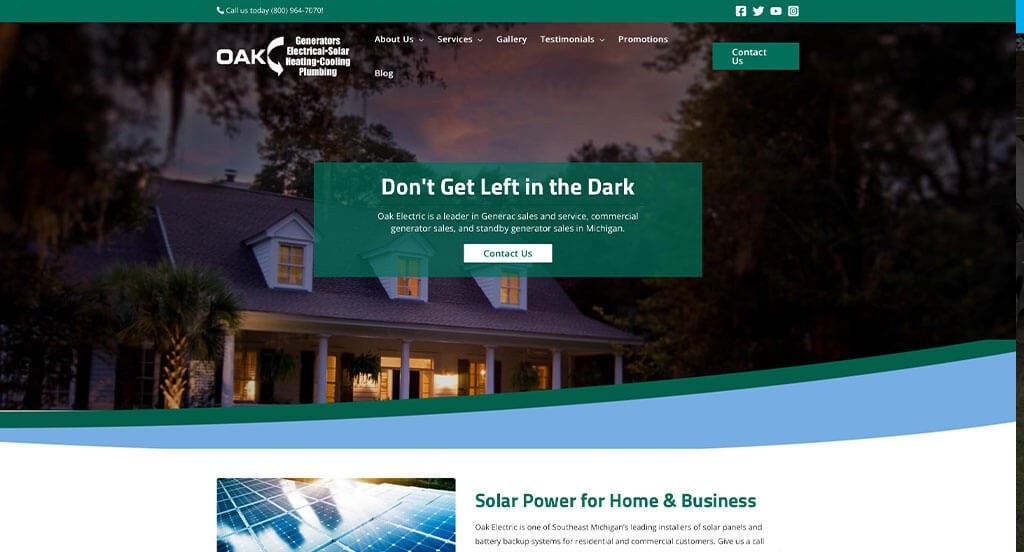
This is a good example of a web design for electricians who are looking for a custom layout. The blue and green accents were likely the most impactful quality in the homepage of this website. The bulleted information to help organize information was definitely refreshing for a unique site. Oak Electric had website accessibility in mind when designing the navigation bar with organized categories within. These were just a few of the numerous qualities in this website we had to consider when putting together this list of top websites for electricians.
6. Green Electrical
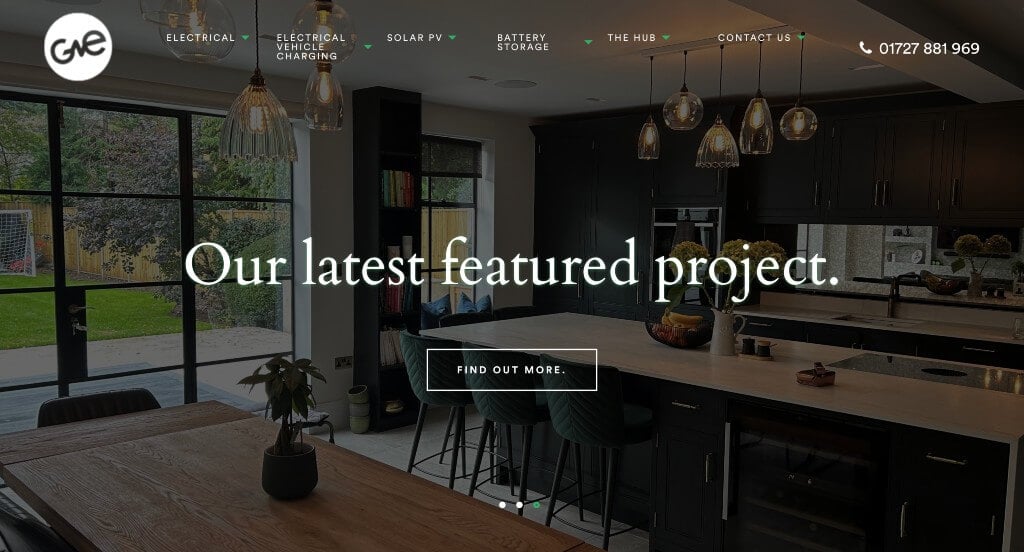
We enjoyed how this example places their logo within their background to create a stunning feel. Customer reviews were included in order to help people understand that they are a trustworthy business. Featuring articles from their blog was a great way to have more information out for viewers to learn. Bright green accents were not only logical but also looked stunning. Drop downs within their navigation bar was helpful to keep everything more organized and easier to find.
7. FA Electric
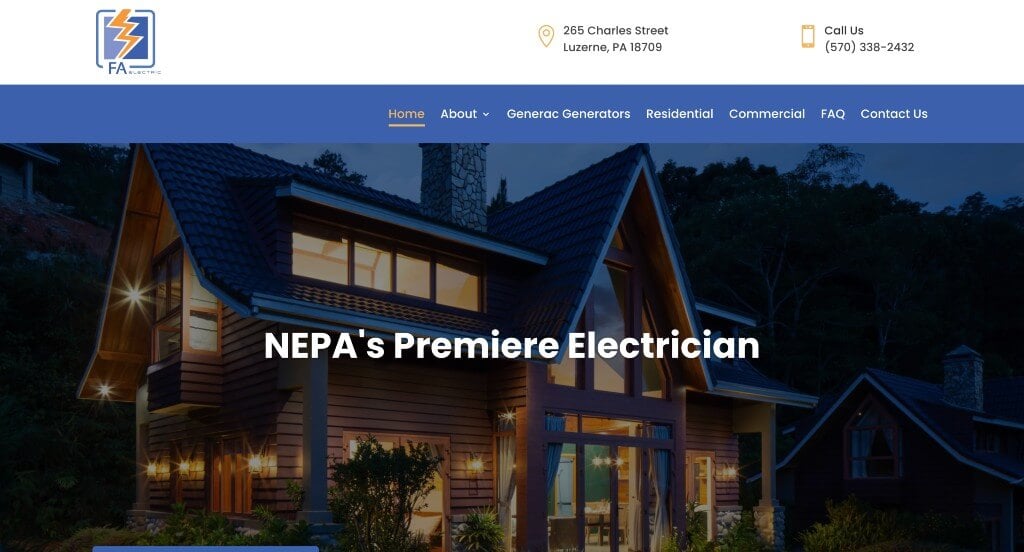
This is a creative website design example for a electricity company looking to build their next custom website. The use of graphics throughout their site was likely the most impactful quality in the homepage of FA Electric. The creative logo design was refreshing for a unique site. FA Electric clearly had a focus on internet marketing when building the page for FAQ. Give some thought to the unique design of this electrician website when developing your next website.
8. Daven Electric
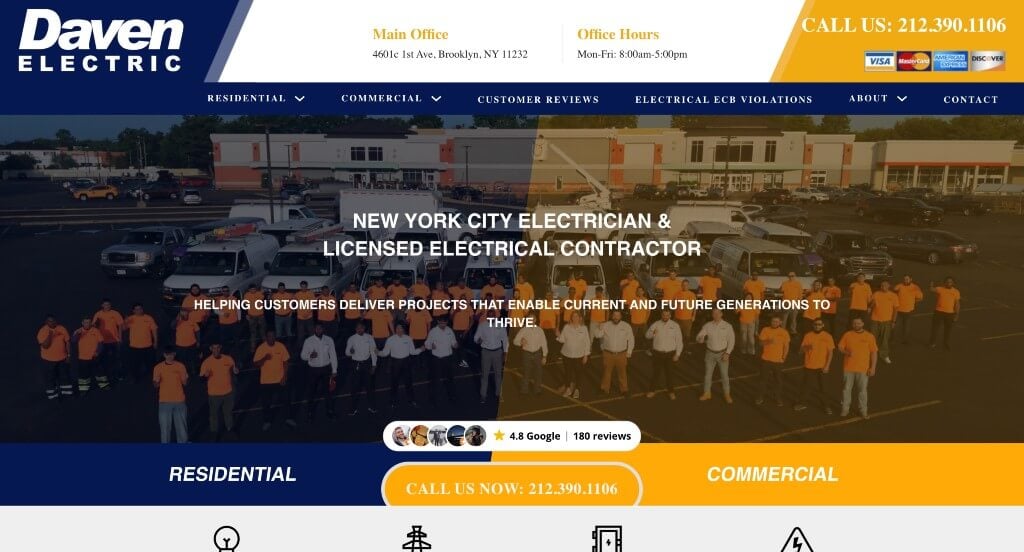
This is a great web design example for an electrician looking to develop a professional website. Our web designers thought this was a good homepage design example for electrical companies because of their stunning color palette. The brightly colored buttons was another thoughtful feature in this professional electrical website we enjoyed. Daven Electric clearly had a focus on internet marketing when creating the news section for their website. Be sure to consider the great design of this electrician website when developing your next website.
9. Randy’s Electric
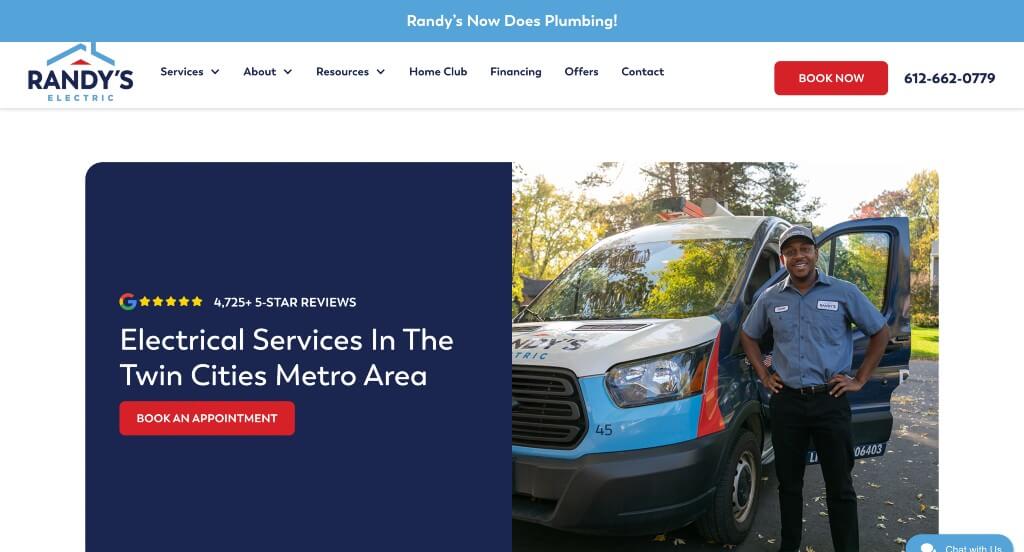
The blue, white, and red color scheme used throughout this custom electrician website stood out to us because it catches the eyes of viewers. As you scroll through the homepage, one of the design qualities we liked was their layout that was aesthetically pleasing. The short and to the point paragraphs were another thoughtful feature in this custom electrician website we enjoyed. Randy’s Electric clearly had website usability in mind when building the inclusion of a search bar for their website. With so many great reasons to consider this electrical website, it’s obvious why we included it in this list of the best websites!
10. Electrician Techs
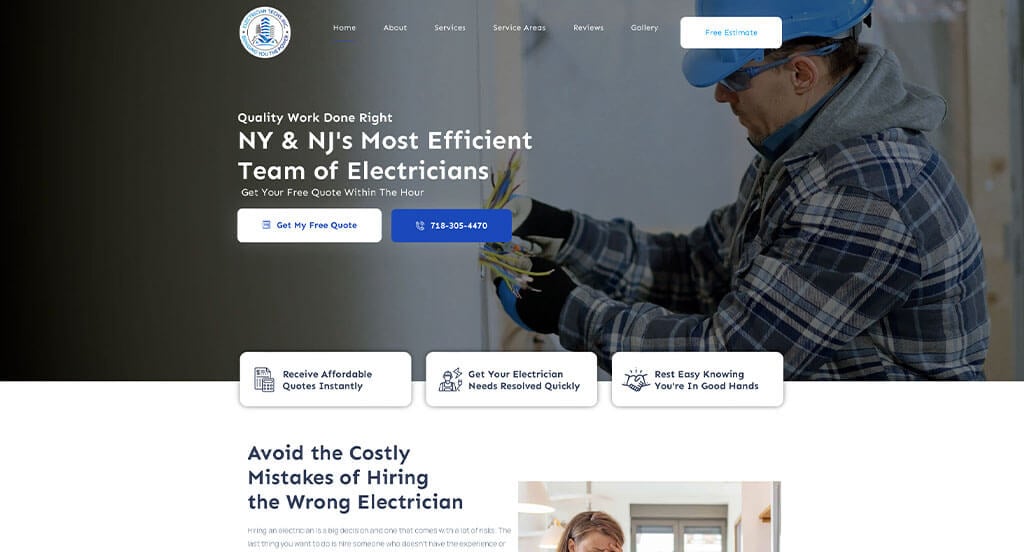
Sporting a clean and intuitive layout, this website keeps things simple for an electrician site. The bold font to emphasize a statement was likely the most impactful quality in the homepage of Electrician Techs. Using bullet points to help organize the information was another unique quality in this custom electrician site we enjoyed. They had website usability in mind when designing the domain for their website that matches their company name. What a great website to review when building out your next website!
11. JLC Electrical Contractors
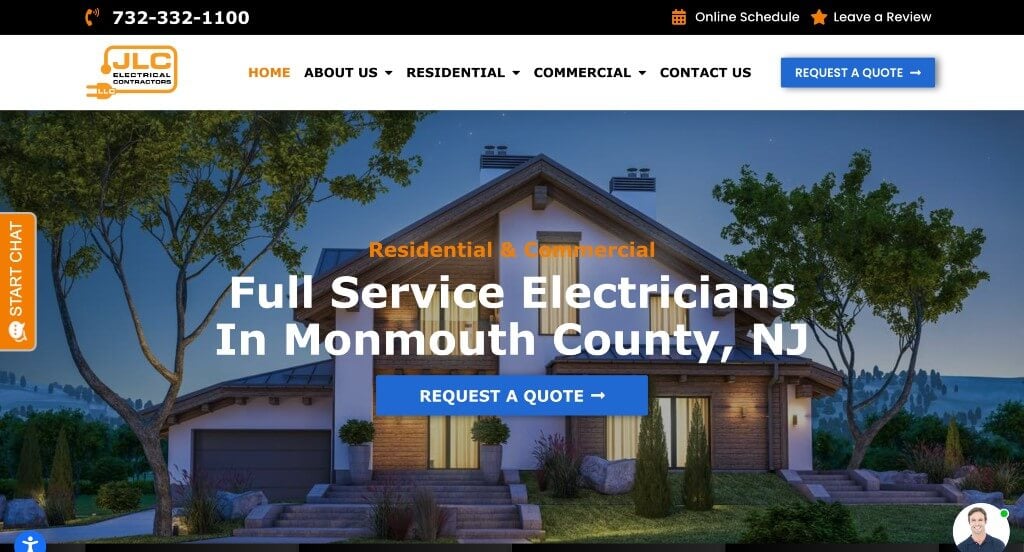
We appreciated how this electrician website used the white, black, gray and orange to create a custom web design layout. We thought this was a good homepage design example for electricians because of the use of graphics. This clean electrician website also does a good job with the use of orange buttons. JLC Electrical Contractors clearly had internet marketing in mind when designing the alternating background colors for their website. If you are looking for template examples for your next electrician website, be sure to check this one out.
12. Blackmer Electric
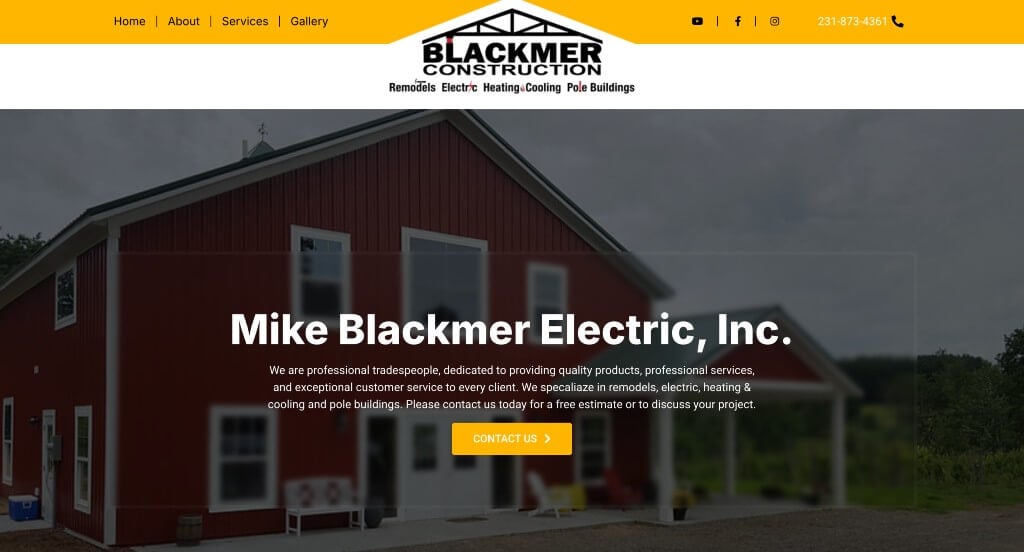
This is a great website design example for electricians who are looking for a custom layout for their next website. We thought this was a good example of a homepage layout for electricians because of their yellow accent colors. This creative electrician site also does a good job with their use of a variety of graphics. Blackmer Electric clearly had conversions in mind when creating the gallery page for their website. For the electricians out there searching for website examples, make sure to check this one out!
13. Desanto Electric
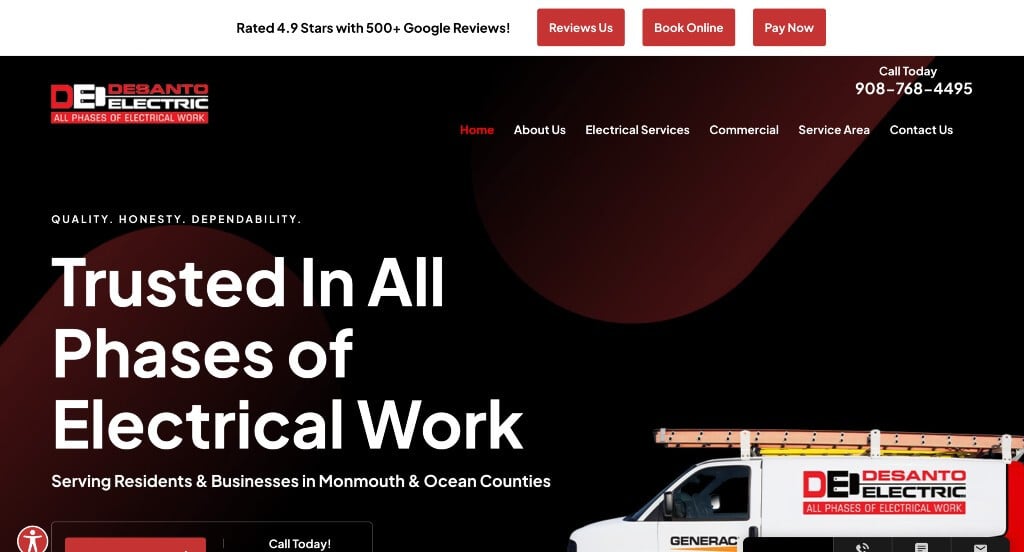
Our web designers noticed the black, red and white color scheme used in the Desanto Electric website, which we liked because it created a bold design. After scrolling past the navigation of this electrician site, you’ll notice their high-quality visuals. The clearly labeled deals were definitely refreshing for a unique electrician site. Desanto Electric clearly had a focus on digital marketing when building the well-labeled navigation bar for their website. So many attractive qualities to consider when ranking this website.
14. CSI Electrical Contractors
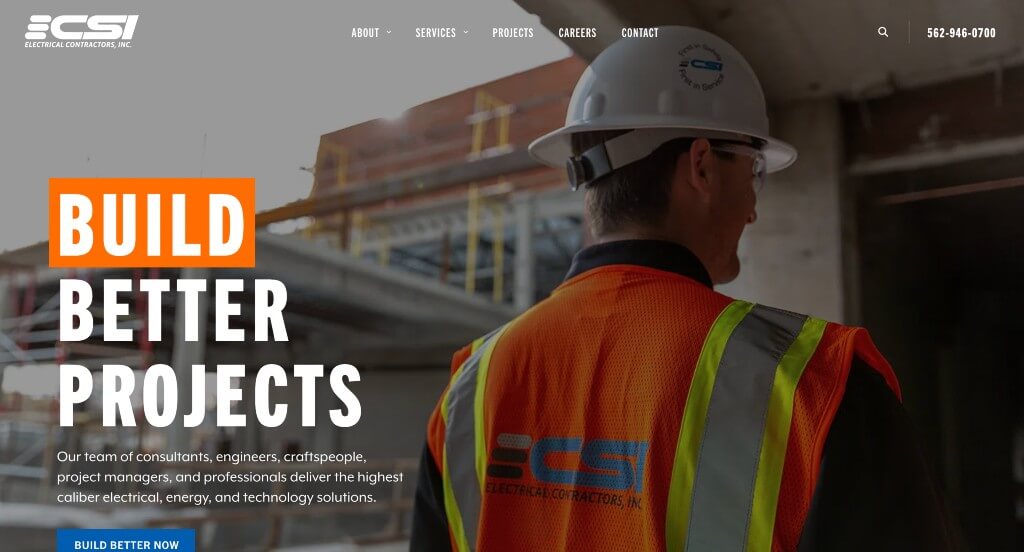
This example does well using large images to grab attention and break up content. Bold fonts are another great choice that makes CSI Electrical Contractors stand out. This logo design can be noticed throughout this entire page which helps to strengthen their brand identity. We liked their collage that uses images and text to share what their company culture is. Along with that, their phone number can be noticed near the top in order to contact them faster.
15. Mr. Electric
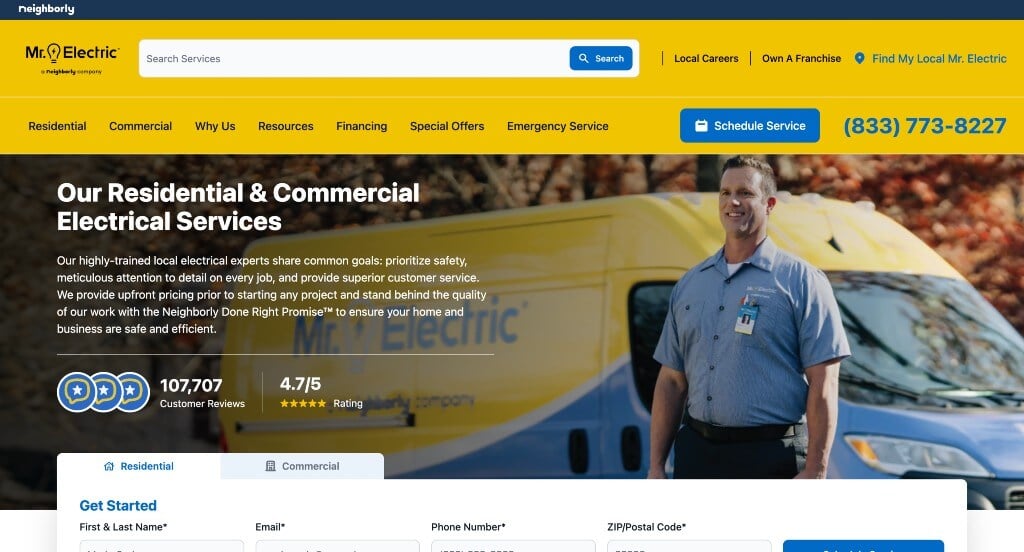
We liked how this electrician website combined the colors of white, yellow and blue to create into a custom web design layout. The simplistic way to book an appointment was probably the most impactful quality in the homepage of Mr. Electric. Another design quality in this clean electrician website was their area for a special offer. They clearly had a focus on website usability when creating the clearly labeled menu for their website. Talk about a great website to have included in this list of top websites!
16. High Class Electric
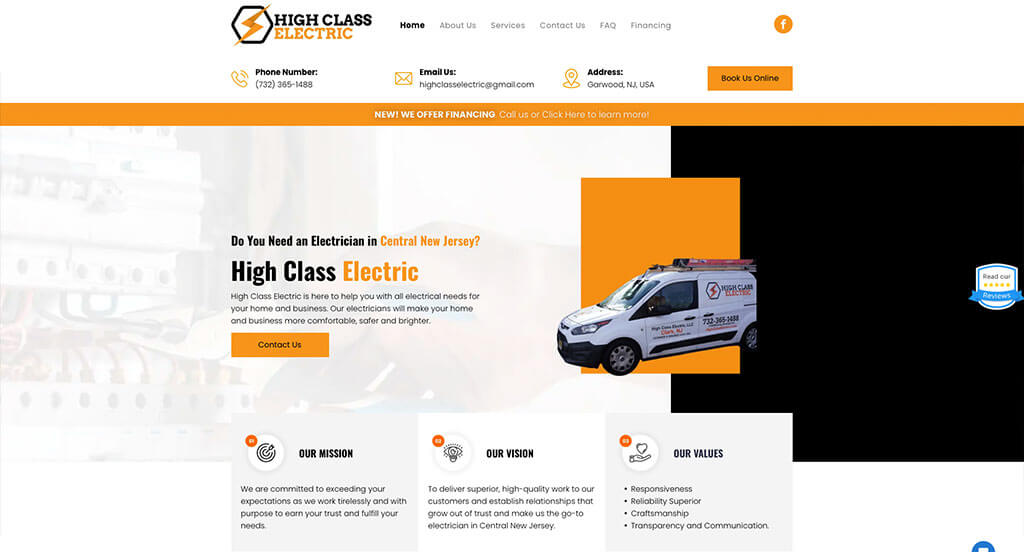
This is a great web design example for electricians who are looking for a professional website. Of all the professional electrical websites we reviewed, one of the features in this custom website we liked was the content that was well organized. The section for their services offered was another reason why we included this custom website in our list of the best templates for electricians. High Class Electric had conversions in mind when designing the pleasing layout for their website. Don’t forget to check this website out while looking through our list of the best electrician website layouts!
17. Clutch Electrical
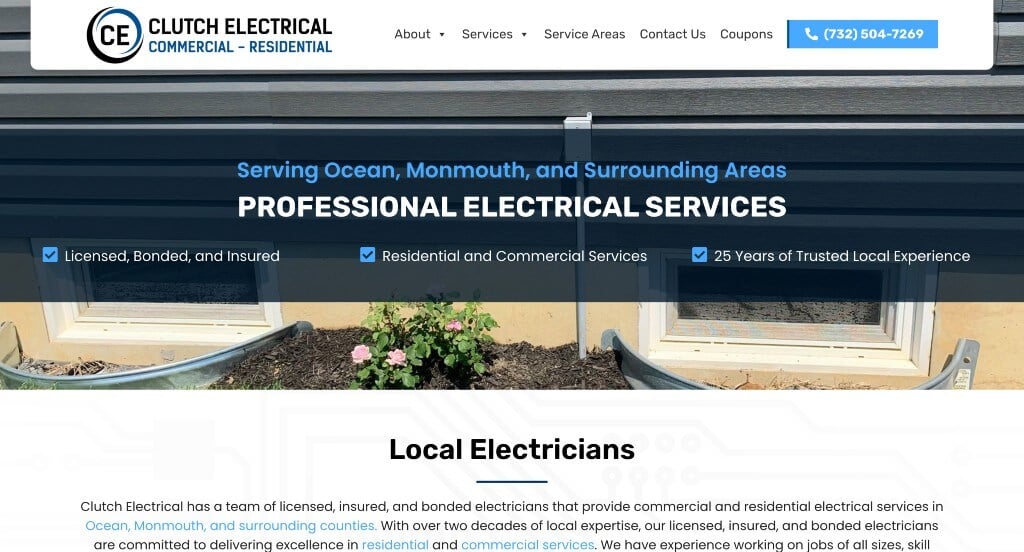
This is a great web design example for electricians who are looking for a professional layout. After scrolling past the header of this electrician website, you’ll immediately notice the variety of blues used in the pages. Another thoughtful feature in this professional electrician website was the patterns used in the background. Their graphics used on their buttons helped make this one of the top electrician websites we considered. Give some thought to the great design of this electrician website when building your next website.
18. Puckett Electric
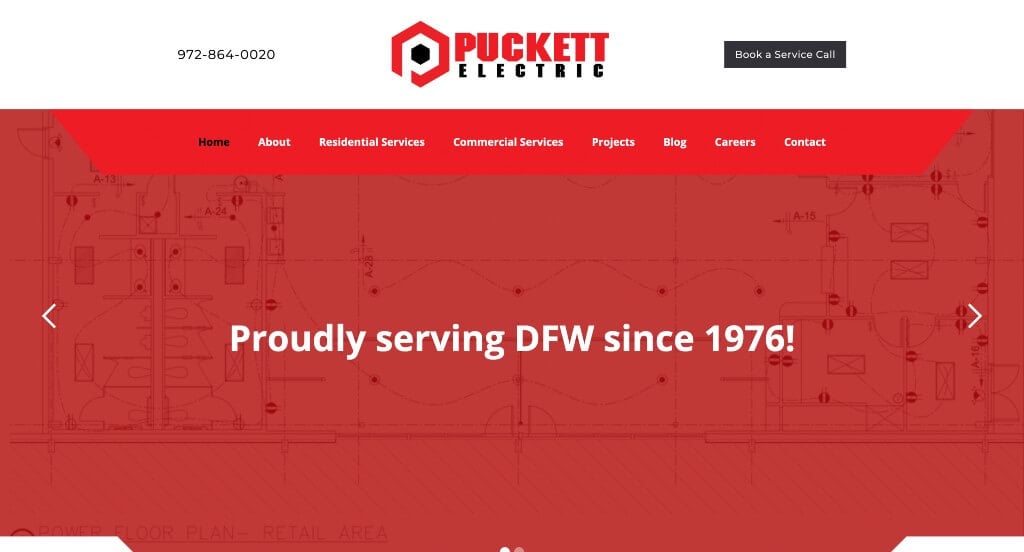
Bright red colors is obviously the first thing that we noticed when entering this site. Along with that, we really love how their logo design looks technological while also including a P for their brand name. Their use of floor plans as a pattern for backgrounds was a great choice for an electric company. Their portfolio was also very helpful to include because it shows what they as a company are capable of.
19. 4th Generation Electric
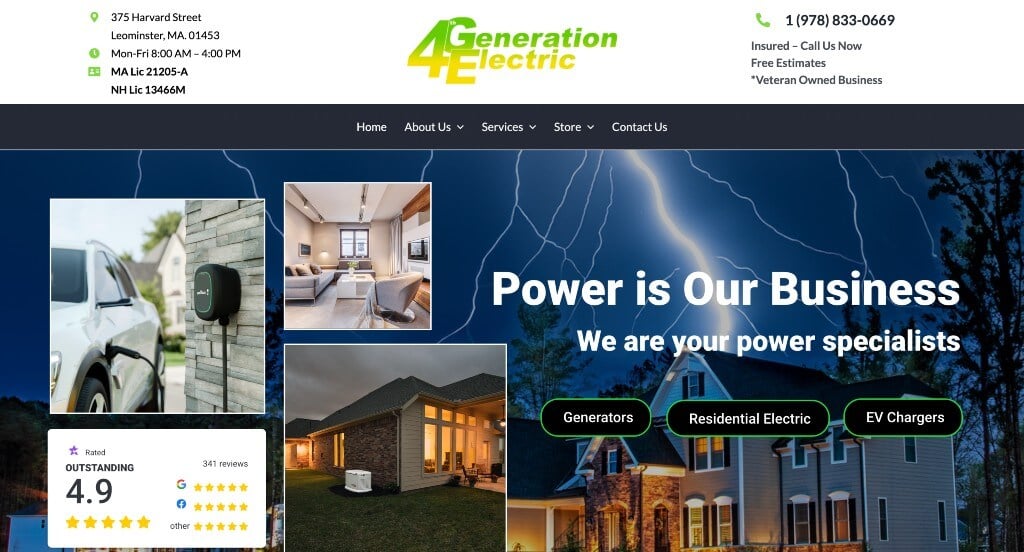
This company’s landing page was one of the first things that we noticed. We enjoyed how they layered image frames on top of their image background to create a unique look. Their buttons are bold and easy to find which was helpful to guide viewers towards additional information. Bullet points are used to keep the information more organized and enjoyable to read.
20. Hall Electrical Ltd
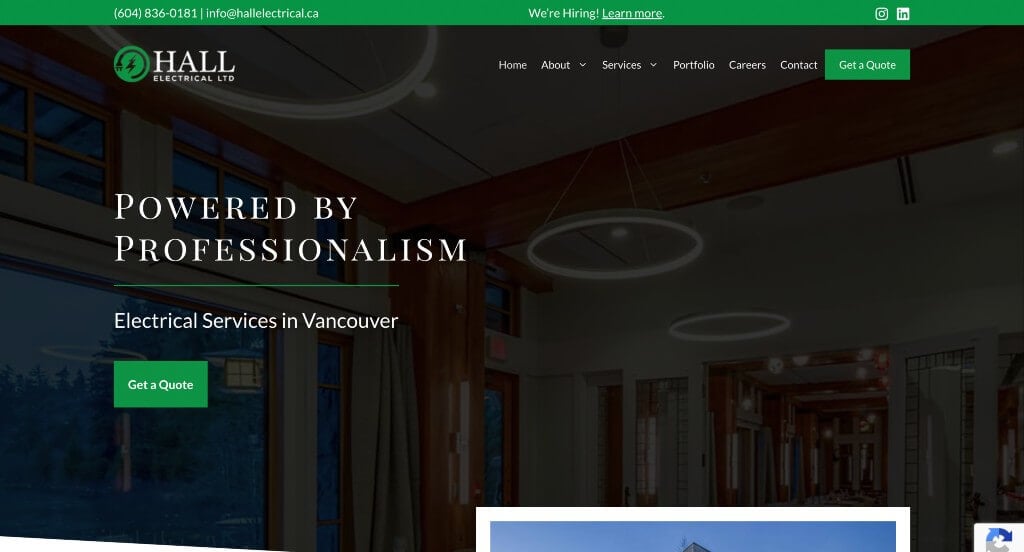
Here’s an example that makes use of professional font to create a reliable template. This logo design was simple but logical for an electric company, which always good. We liked their alternating backgrounds that are sometimes white and others a filtered image because it breaks up content more. Adding in lots of buttons is helpful to guide people towards additional information and keep the pages uncluttered.
21. All American Electric
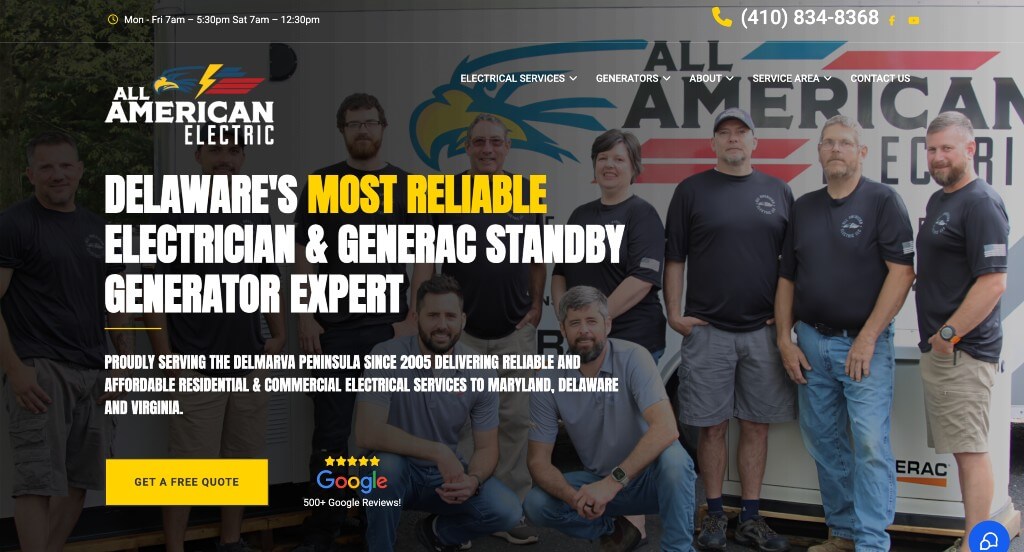
This is a creative website design example for an electrician looking to build their next website. One of the homepage features of All American Electric we noticed was their bold lettering because it was rather refreshing for an electricity website. Another thoughtful quality in this custom electrician website we liked was the subtle animations. They clearly had website usability in mind when designing the simple contact information for their website. What a great website to review when designing your next website!
22. Wilcox Electric
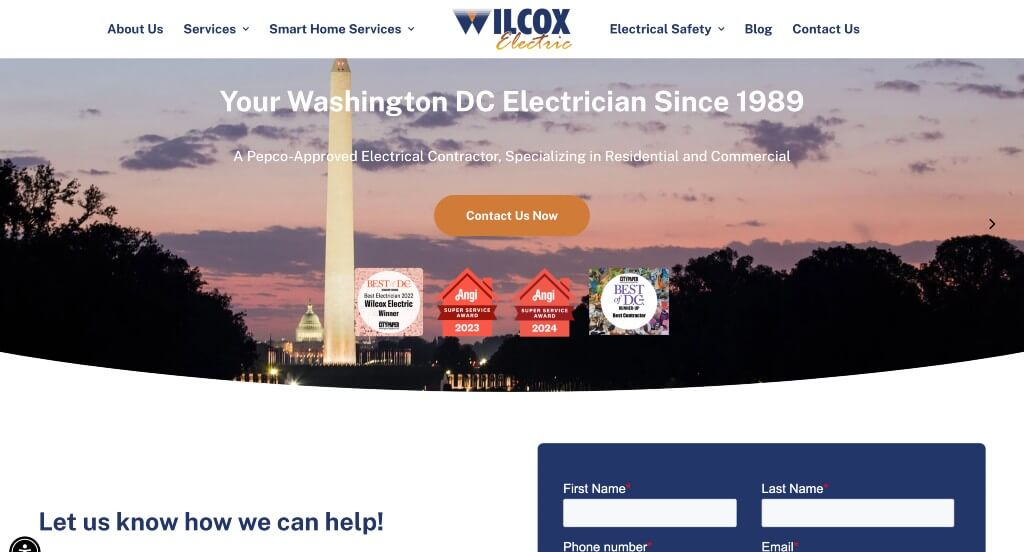
This is a creative website design example for an electricity company looking to build their next professional website. The interesting logo was probably the most impactful quality in the homepage of this website. Another feature in this professional electrician website we liked was their stunning color choice. Wilcox Electric clearly had a focus on conversions when creating the display of their awards. For electricians looking for ideas on their next website, this example will definitely be one to keep in your back pocket.
23. Bailey & Shipp Electric
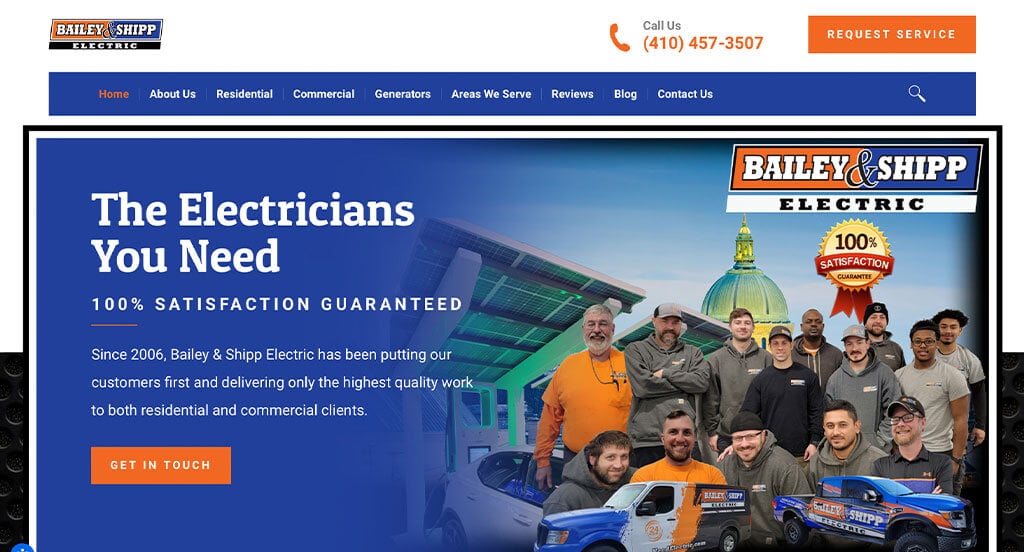
This is a good example of an electrician website design for a person looking for ideas. The part of this website’s homepage that caught our attention was definitely their beautiful imagery. The bright colors were absolutely a consideration when ranking Bailey & Shipp Electric in this list of the most professional electrician websites. From a marketing viewpoint, for an electrical website we really liked the way they utilized a variety of different information for their site. Give some thought to the great design of this electrician website when building out your next website.
24. Haas & Sons Electric
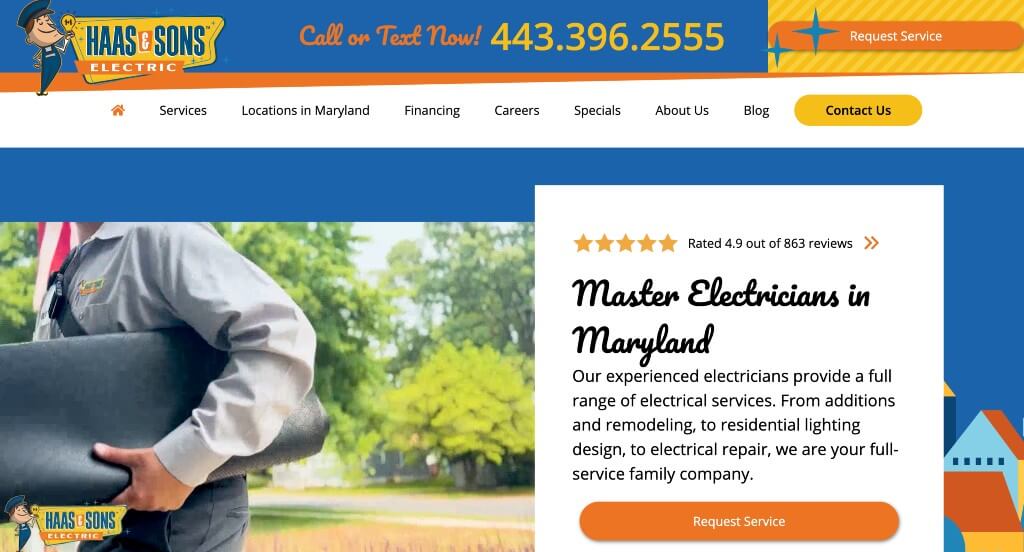
This is a great website example for electricians who are looking for a custom look and feel for their next site. After scrolling past the header of this electricity site, you’ll immediately notice their fun font choices. Another design quality in this creative electrician site we liked was their use of a combination of graphics. They clearly had website accessibility in mind when creating the clearly labeled menu for their website. Don’t scroll past this website when hunting for design ideas for your next electrician website!
25. Magothy Electric Co.
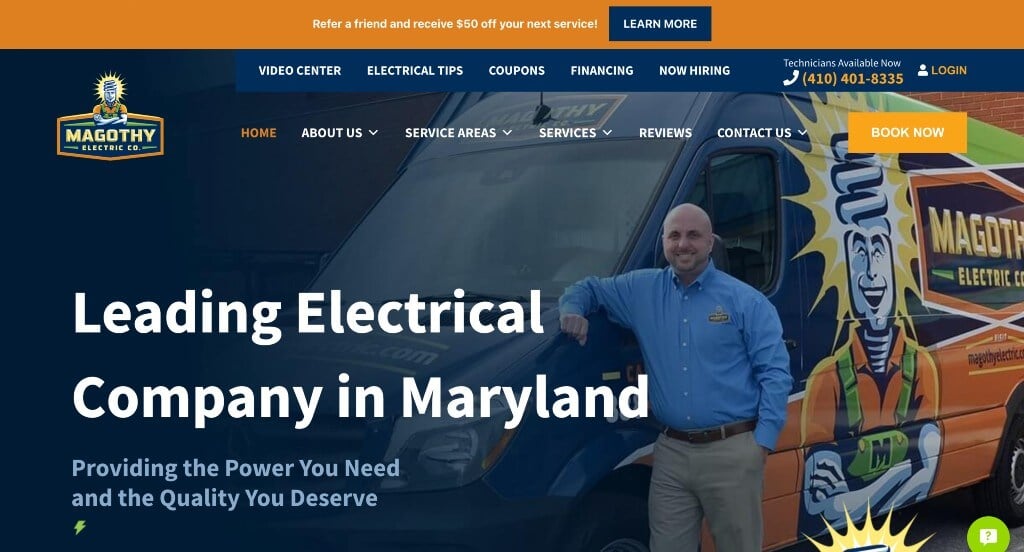
We appreciated how this electrician website used the colors of orange, blue, white, green and yellow to create a custom web design. The frames for their images that matched their logo design was definitely the most impactful quality in the homepage of this website. The bright orange banner displaying important offers was another reason why we included this website in our list of the best websites for electricians. The customer reviews with images of the work their company did helped make this one of the best electrician websites we considered. There was no shortage of reasons to include this website in our list of websites for electricians to consider when building out their next website.
26. Clinton Electric Co.
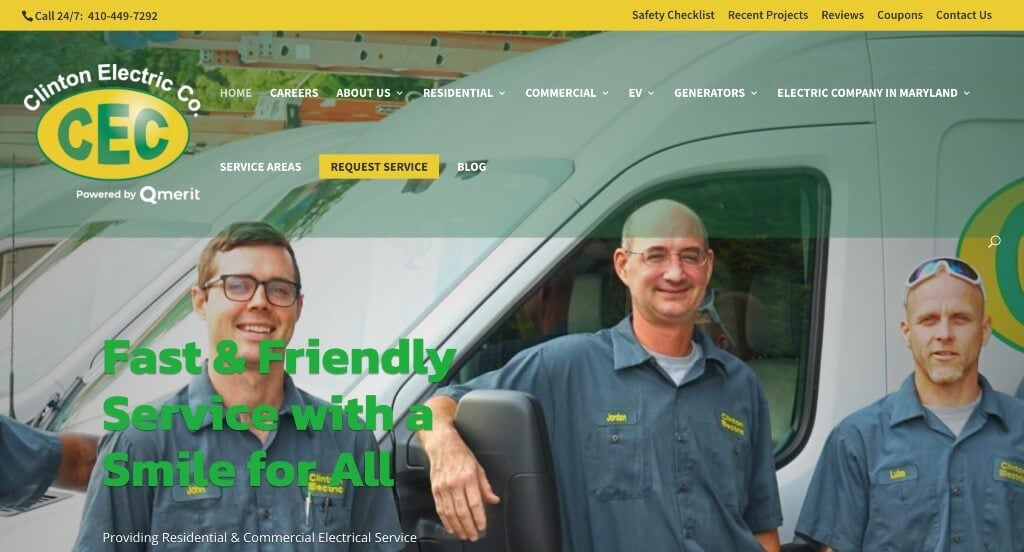
This is a creative website design example for an electrician looking to build their next professional website. The most attention grabbing aspect in this electrician website was definitely their easy to use template. The different sized font to help emphasize titles was refreshing for a custom electrician site. Their navigation bar with organized sections helped make this one of the best electrician websites we reviewed. Another amazing website to add to this list!
27. Benchmark Electric Co
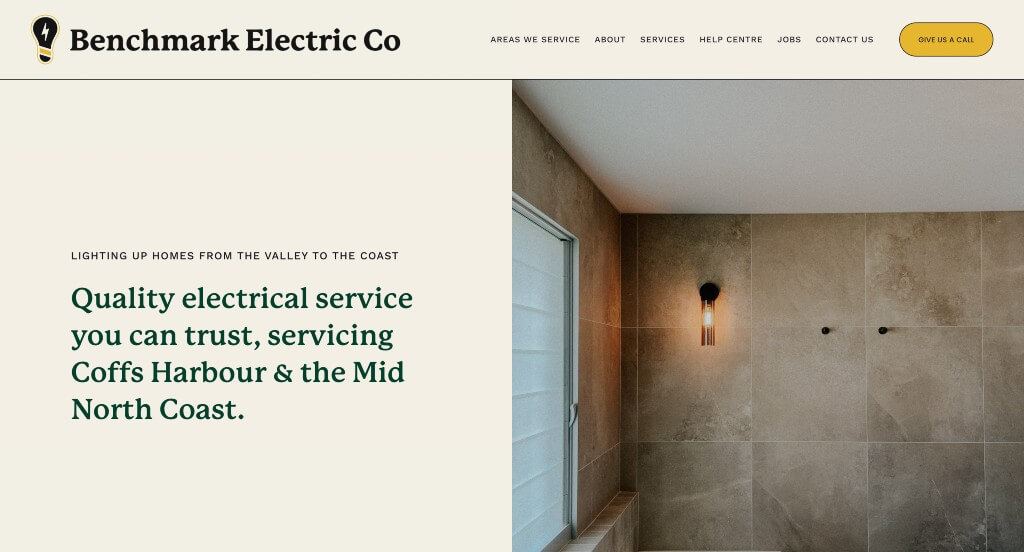
Between this company’s color scheme and text, it feels very simplistic and organic. Short paragraphs makes it much easier to skim and stay engaged in this business’ content. We liked their rounded graphics that appeared throughout the page. They did a nice job with their domain that matches their company name making for a stronger brand identity.
28. John Goudie Electrical Contractor
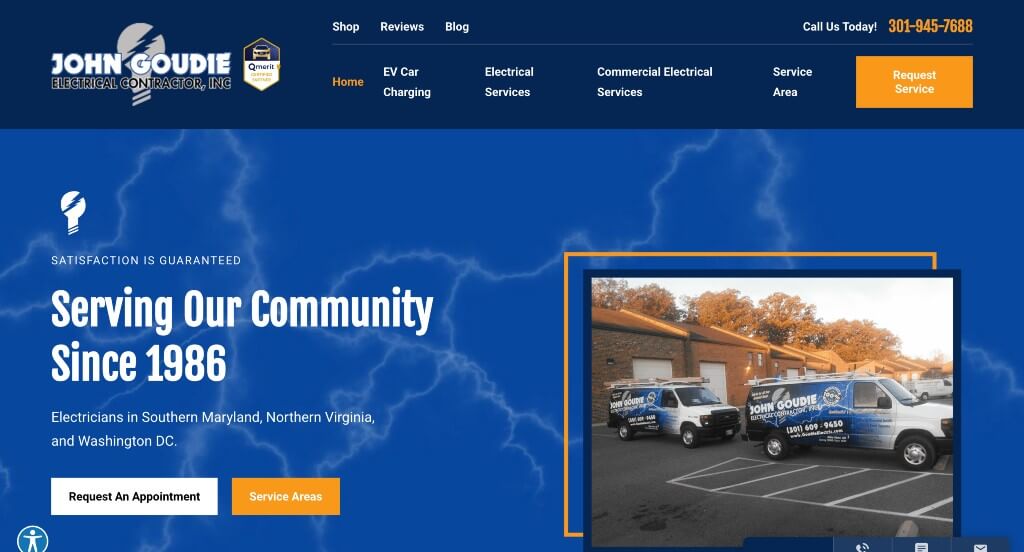
This is a good example of a website for an electrician looking for a custom look and feel for their next site. The use of a pattern for their backgrounds was likely the most impactful quality in the homepage of this website. The creative logo design was refreshing for a custom site. John Goudie Electrical Contractor had conversions in mind when creating the staggered layout for their imagery for their website. With so many good reasons to consider this electrician website, it’s no wonder we included it in this list of the best websites!
29. Nipper Electric
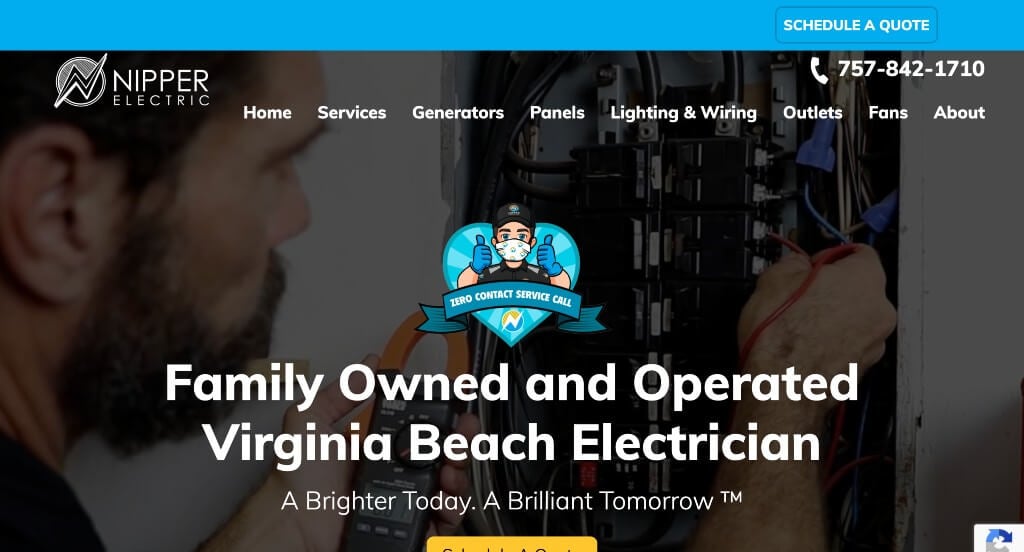
This is a great website design example for an electrician looking to get inspired for a custom layout. As you scroll through the homepage of this website, one of the design qualities we liked was their animated feel to their site. The professional font was definitely refreshing for a custom electricity website. They clearly had conversions in mind when building the subtle animations for their website. If you are looking for template ideas for your next electrician site, give some thought to this one.
30. Contract Electrical
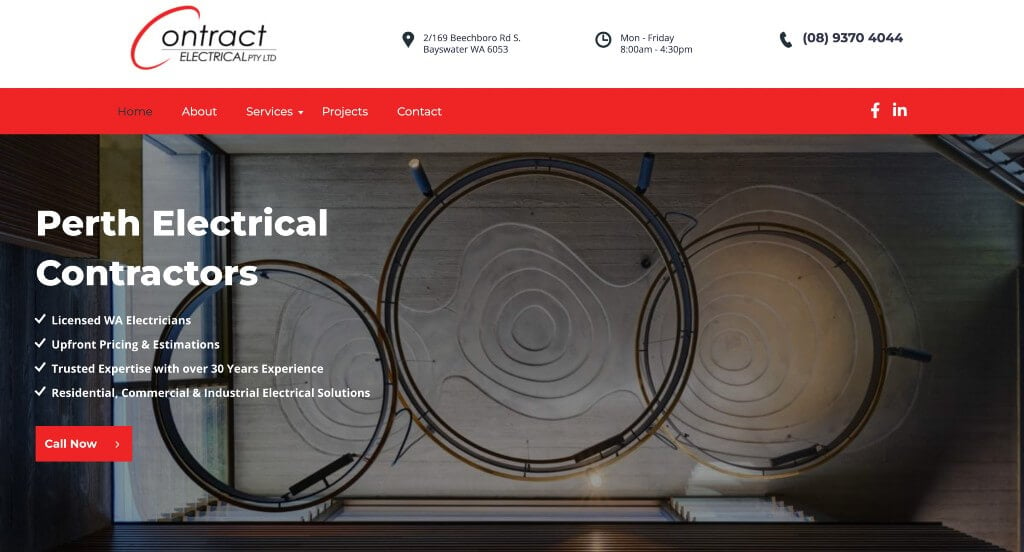
One of the most impactful parts about Contract Electrical was their use of bullet points to organize content better. Displaying their past projects is something that we find helpful. Listing their services so that customers aren’t disappointed was another feature that we really enjoyed. Including client testimonials is always helpful no matter what type of business you own.
31. 5 Points Electrical
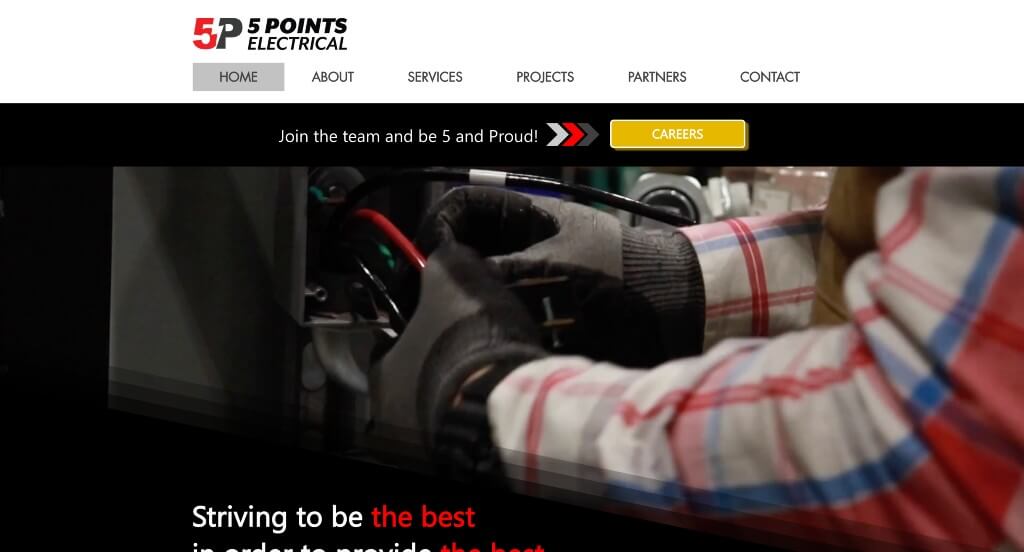
Starting this business off with an automatically playing video was something that we really liked because it helped introduce their business. We liked the subtle animations that appear as viewers scroll through the pages. Their red accents really grab attention and look stunning on a black background. Their use of arrow graphics was another thing that we liked about this example.
32. Cline Electrical
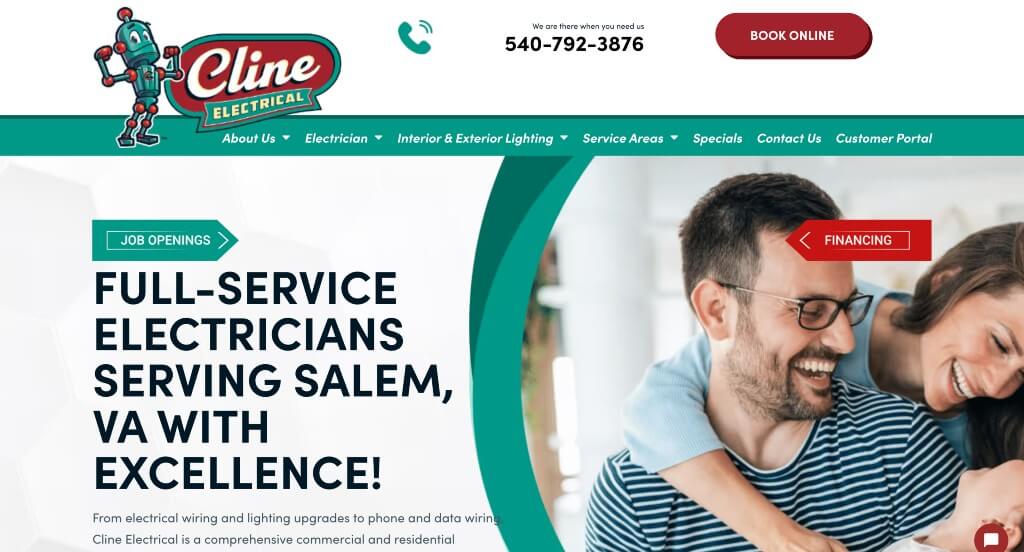
This is a good example of a template for electricians who are looking for a custom look and feel for their next website. Of all the custom electrician websites we reviewed, one of the features of this custom website we liked was their logo that appears all throughout their site. Their creative font choices were definitely refreshing for a professional site. They clearly had conversions in mind when designing the buttons to enhance usability throughout their website. Any website designer making websites for electricians will want to consider checking this website out.
33. Melbourne Wiring Services
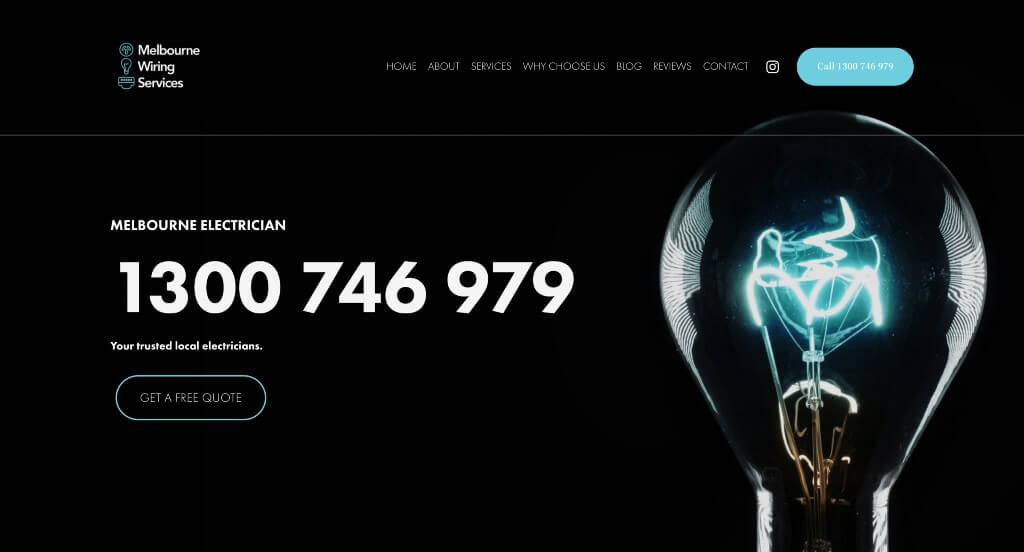
This example grabs our attention right away because of its dark background right away, showing the power of their service. Featuring articles about news and tips was nice for those wishing to learn more. Introducing their managing director helped to build trust between their customer and this company as a whole. A page dedicated to why clients should chose them was another choice that we appreciated.
34. Clark Electric
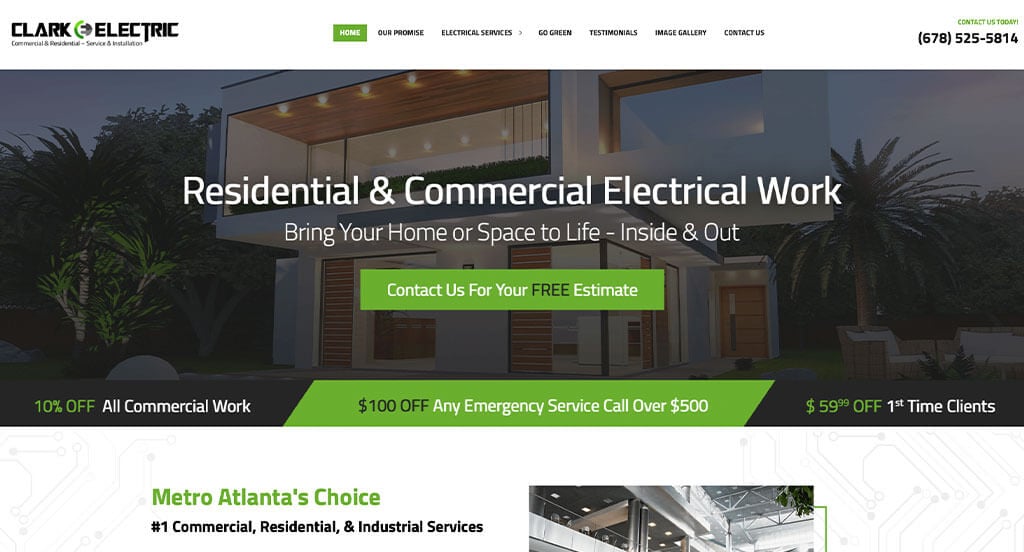
This is a good example of a website for an electrical company looking for a custom look and feel for their next site. The most attention grabbing aspect in this electrician website was definitely their creative logo design. Another feature in this professional electrical site we liked was the imagery to break up the content. The graphics used as a background helped make this one of the best electrician websites we looked at. What a great website to review when building out your next electricity website!
35. Gibbs Electric Company
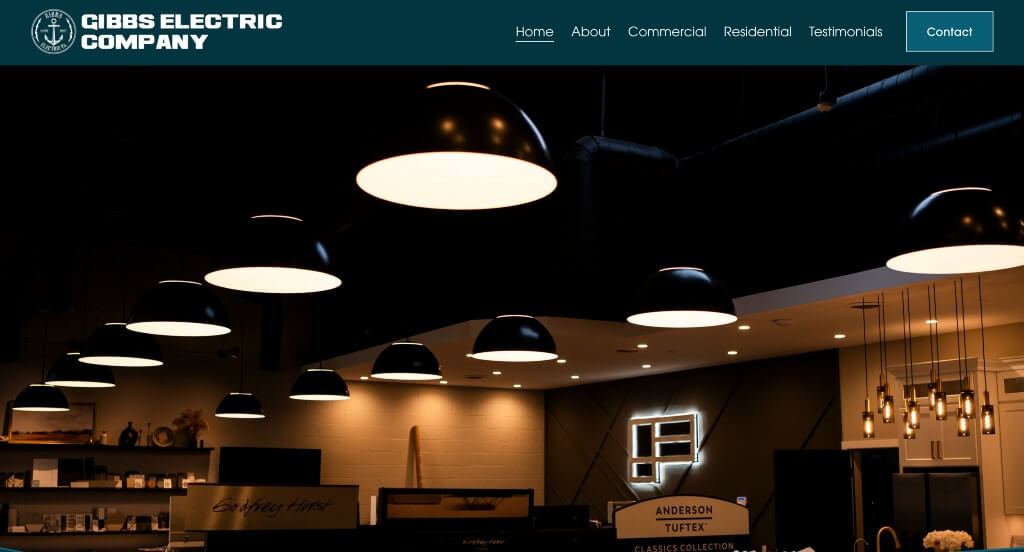
This is a stunning example that uses lots of dark colors to highlight this company’s lighting aesthetic. Their images were of extremely high quality and improved their pages lots. We loved their use of simple patterns for a background because it created a more unique feel. Bold fonts was another thing that Gibbs Electric Company did a great job with. We also thought that their logo design was well built and looked great when repeated throughout the page.
36. Coastal Electric of Georgia
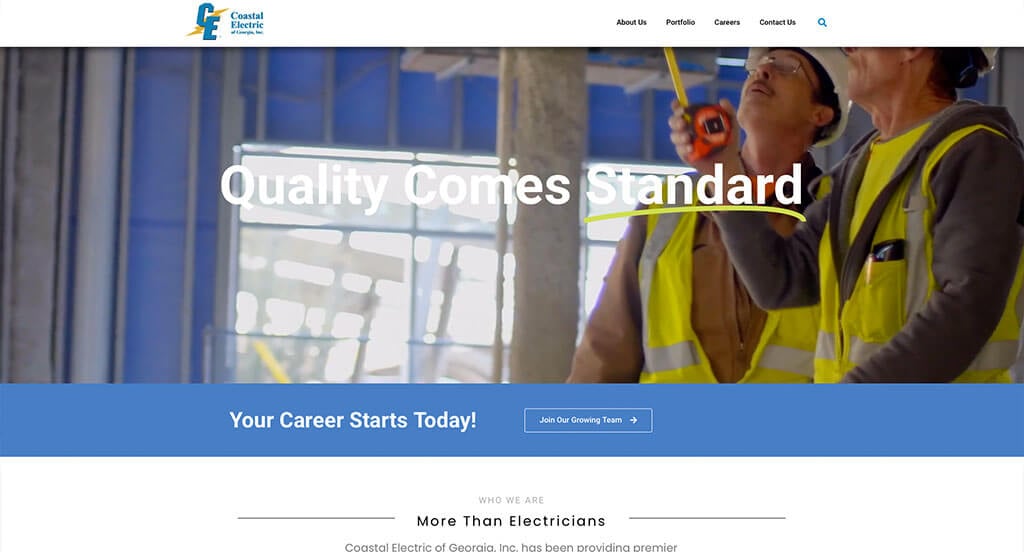
This is a great website design example for electricity companies that are looking for a custom website design. The automatically playing video was likely the most impactful feature in the homepage of this website. The use of tallying statistics was a nice touch for a professional site. Coastal Electric of Georgia clearly had conversions in mind when designing the blog for their website. Be sure to consider the one-of-a-kind design of this electrical website when developing your next custom website.
37. Belleville Electric
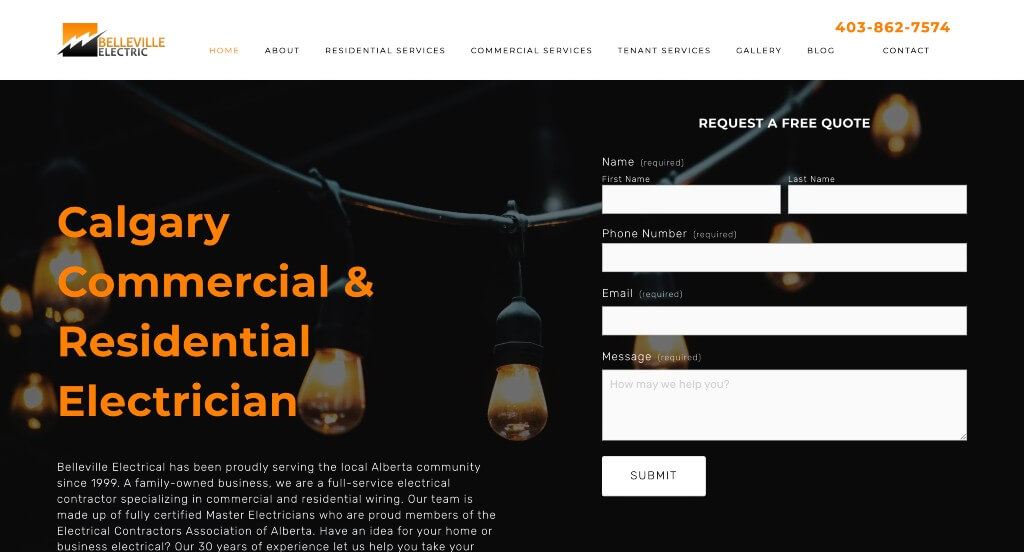
The color scheme used for this page was smart due to the fact that they are an electrical company. They do a great job balancing their white space and creating an unforgettable design. Short paragraphs are a feature that appears within Belleville Electric in order to keep people engaged with their content longer. Small icons using bright colors was something that we liked to see within their pages. This navigation bar was also very well organized making it easy to find more information.
38. Bowen Electric
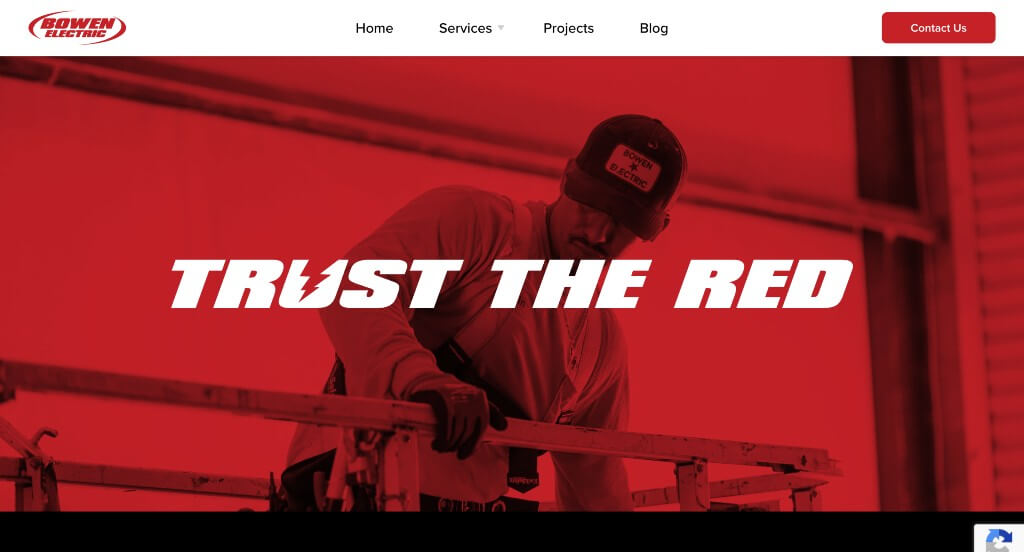
Here we have an example that really stands out because of their bright red colors. The phrase “Trust the Red” reappears in many places which helps reinforce their signature color. Bold fonts are a perfect choice for these titles so people know what to expect while reading content. Adding in a blog was something that we don’t always see, but it’s appreciated. A services drop down lets viewers know what kind of services they offer.
39. Tactical Power Services
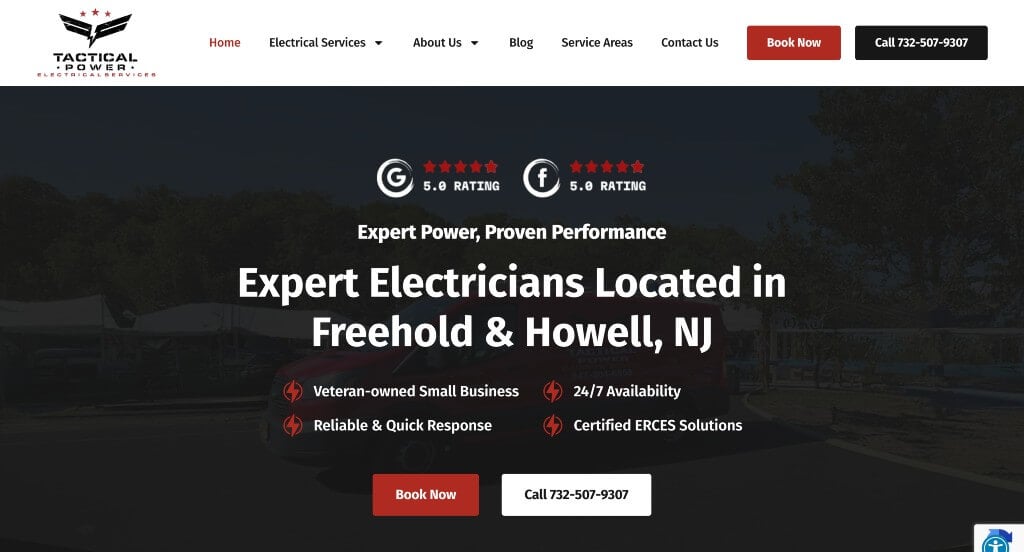
Tactical Power Services has a great looking website that uses a white, gray, red, and orange color scheme. One of the homepage features of Tactical Power Services we noticed was the short and to the point paragraphs. The thoughtful logo design was refreshing for a professional site. Tactical Power Services clearly had website marketing in mind when designing the graphics used as bullet points in their website. Don’t scroll past this website when considering design ideas for your next electricity website!
40. NuBlue
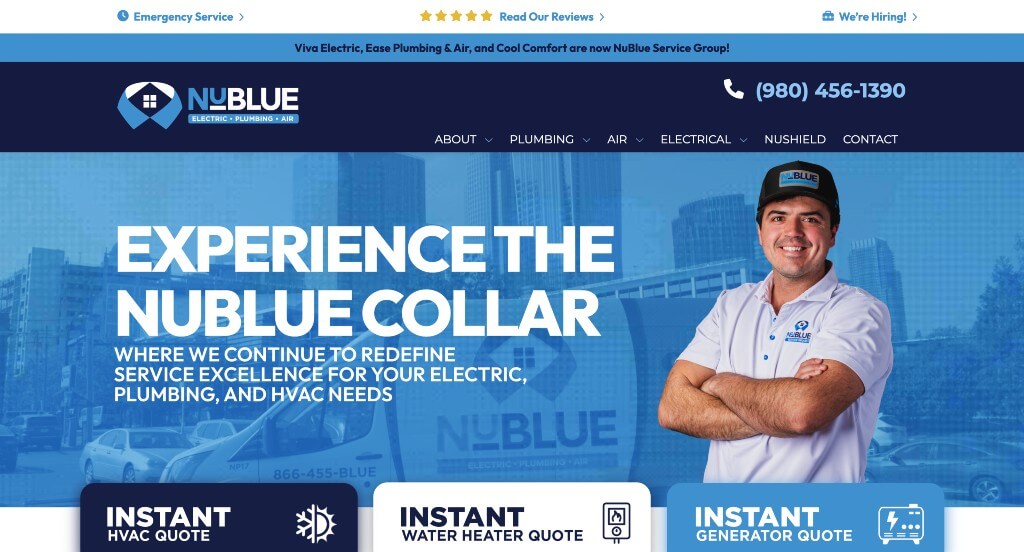
The first thing that we noticed about this example was this company’s logo design that makes use of a shirt collar and a house graphic. Along with that, they used a few shades of blue paired with white in order to create a thoughtful color palette. Adding in promotions to help customers save money was another smart choice. A dotted texture shows up in their backgrounds occasionally which is also nice.
41. T&D Electrical
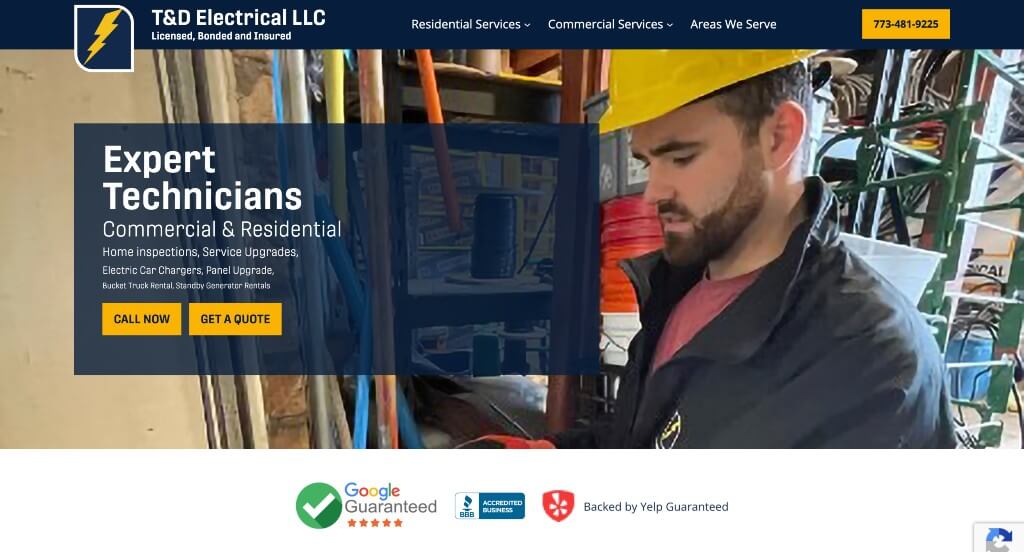
For an electricity website, they did a great job utilizing the white, yellow and blue colors throughout their site. The different sized fonts was definitely the most impactful feature in the homepage of T&D Electrical. The layout with a good balance of white space was another feature in this custom electrical site we enjoyed. They clearly had a focus on internet marketing when designing the gallery page for their website. You won’t be disappointed after reviewing this website for design ideas for your next website!
42. Mister Sparky
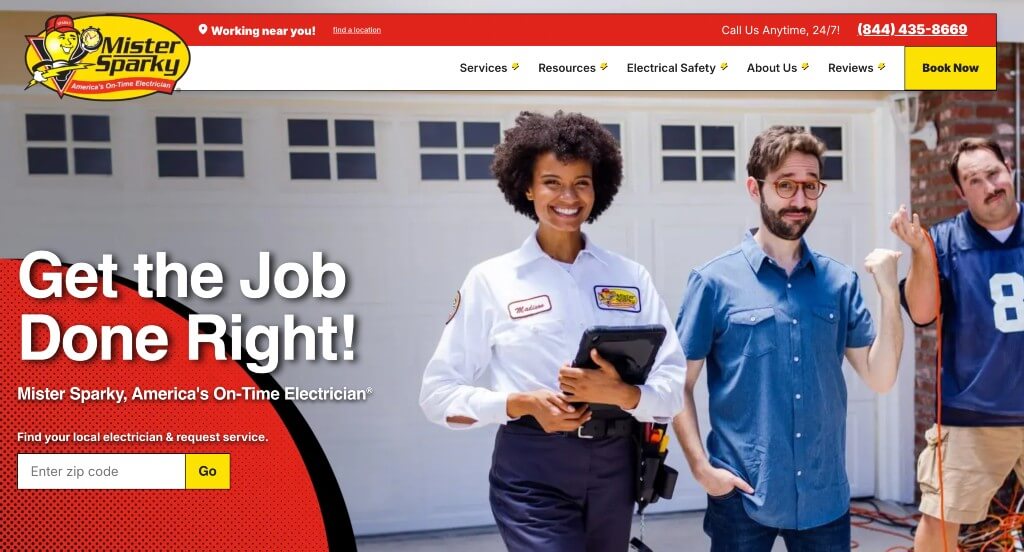
This is a great website example for electricity companies looking for a custom site layout. The animated look to their page was likely the most impactful quality of the homepage of Mister Sparky. The circle frames were another feature in this custom electrical site we enjoyed. The domain for their website that matches their company name was one of the marketing features that really stood out when reviewing this website. Any website designer making websites for electricians will want to consider checking this website out.
43. Ridgeline Electric LLC
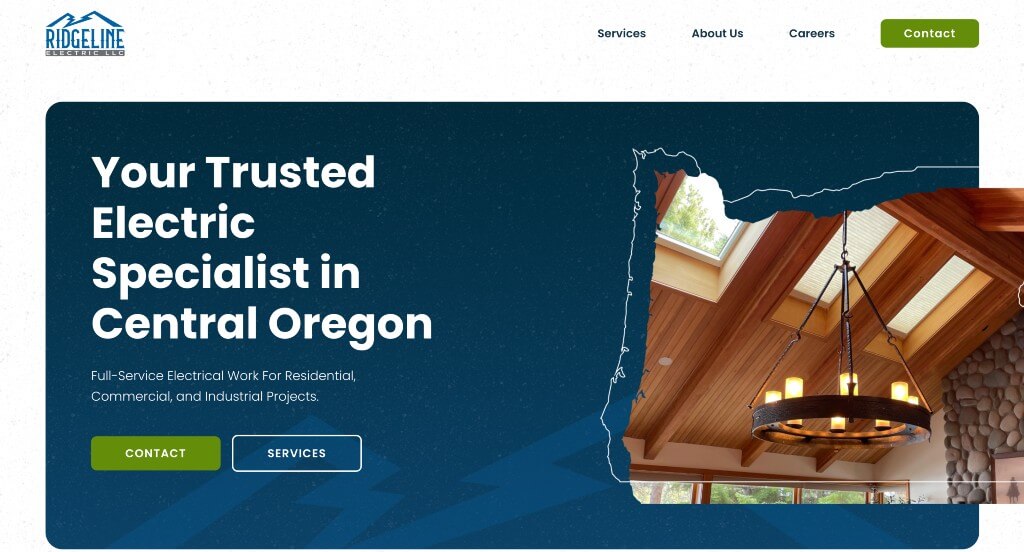
Something that we liked about Ridgeline Electric LLC was their logo that blends a lightning bolt and a mountain. Along with that, we thought it was cool how they used the outline of the state they are located in as an image frame. Don’t forget about their textured background that, although subtle, really adds to their website. Lots of buttons were also included to guide people towards more information which is a nice addition.
44. Davis Electric
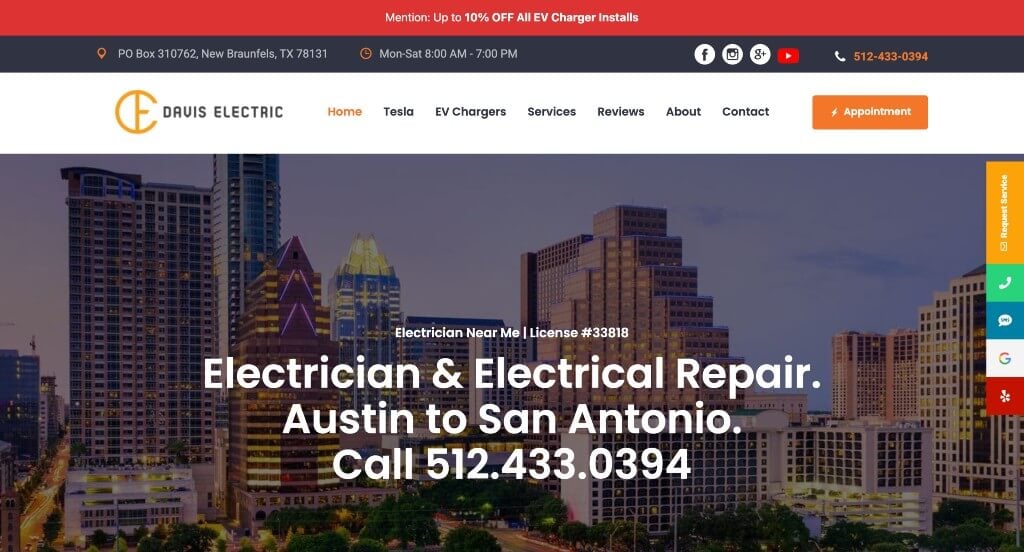
Right away, this company makes use of a map that shows which cities they service. We also felt like their logo design was sleek but logical, using the initials of their company name. Occasionally overlapping images helped to create a more unique look for their pages. Their font is also very simple and professional which is helpful to have a reliable site.
45. Vancity Electrician
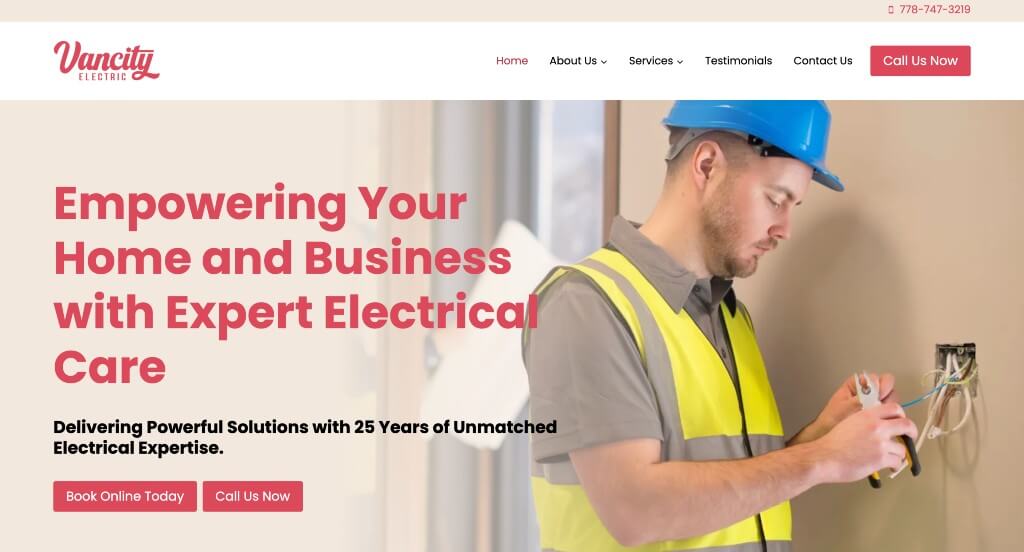
This simply designed example is professional and gets the job done. Their bold font and buttons were features that we appreciated. We thought it was smart how they used their logo over and over as a background. Adding in videos was an interesting addition that we enjoyed. Small icons were used as bullet points for their information.
46. Willxon Electric Inc
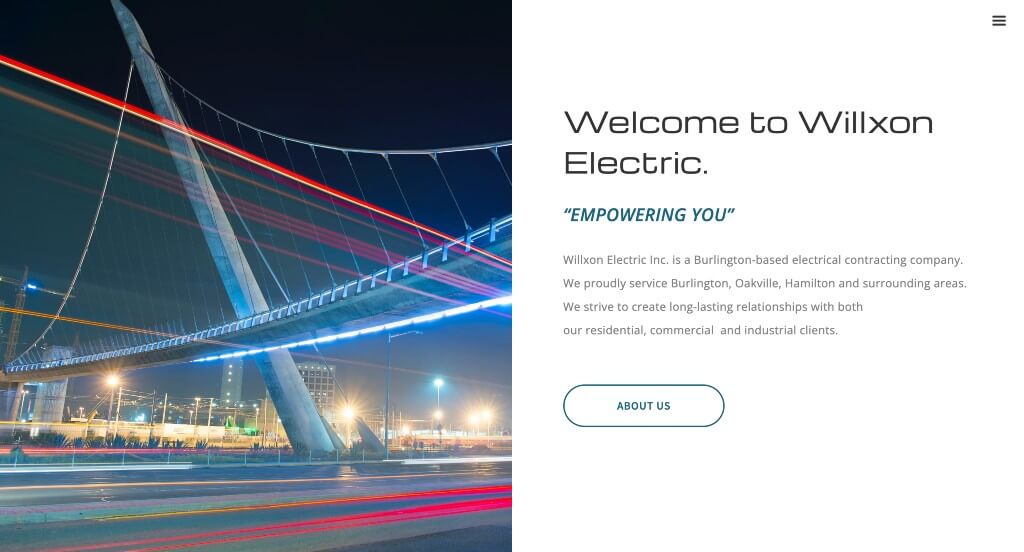
We enjoyed this modern template that sticks to a simple color scheme. Their vertical image look was another thing that we enjoyed because it stands out from competitor sites. Sharing their clients and partners helps to build trust with those who are unsure about this service was a great idea. Their font was one that felt unique to us which is always a great choice.
47. Sunrise Electric
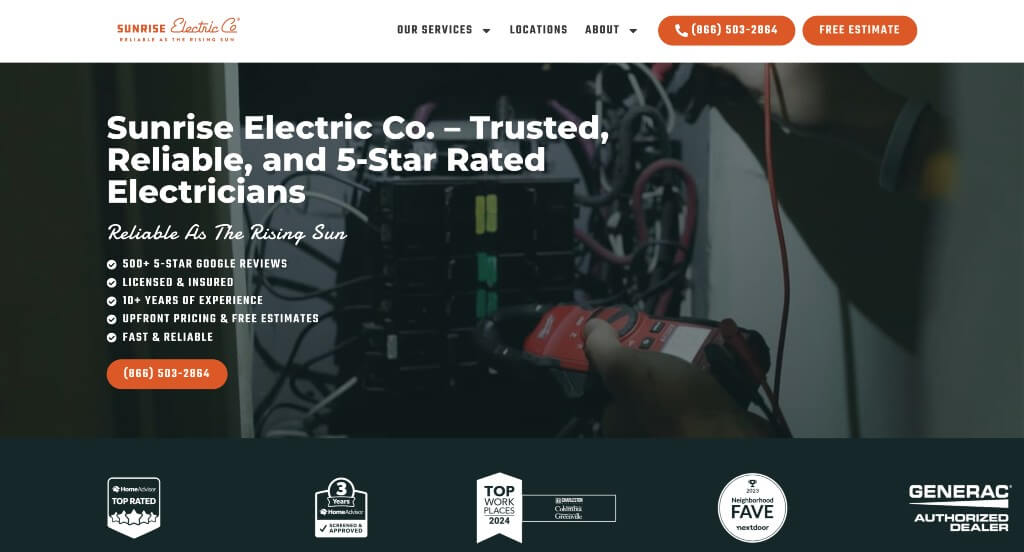
This is a great electrical web design example for someone looking to develop a professional website. After scrolling past the navigation of this electrician site, you’ll immediately notice their free evaluation survey. The use of icons was another reason why we included this website in our rankings for the top web design ideas for electricians. They clearly had website accessibility in mind when building the layout that was well put together. What a great website to review when designing your next website!
48. Wes Carver Electric
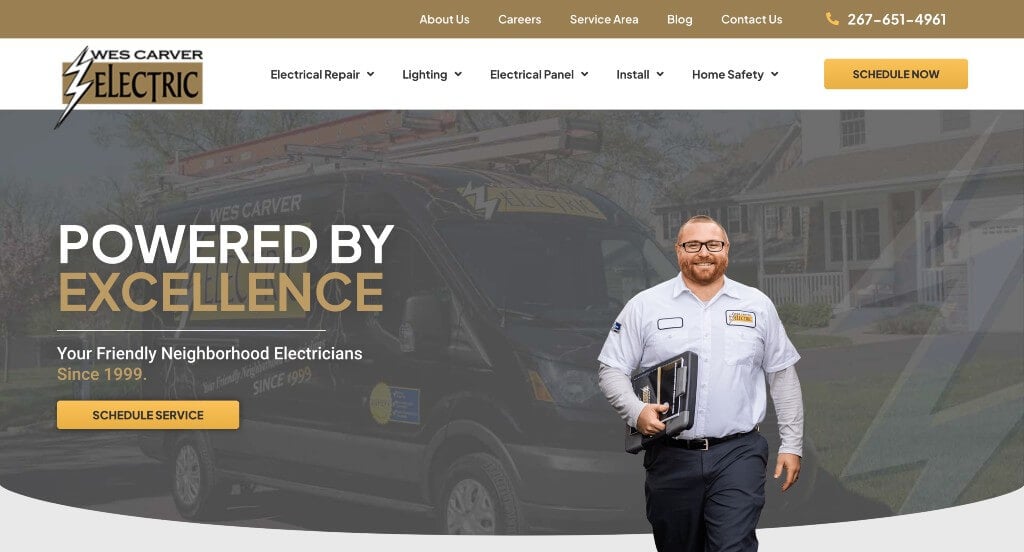
We liked how this electrician website combined the colors of a neutral color palette to make a custom web design. The use of bullet points was definitely the most impactful quality in the homepage of Wes Carver Electric. The simple layout was another feature in this custom electrical site we enjoyed. Wes Carver Electric clearly had website usability in mind when creating the clearly labeled menu for their website. These were just a few of the numerous qualities in this website we had to consider when putting together this list of top websites for electricians.
WordPress Electrician Themes
You can find free themes at wordpress.org, or consider electrician-inspired templates at ThemeForest.
Wolt – Themeforest
$59
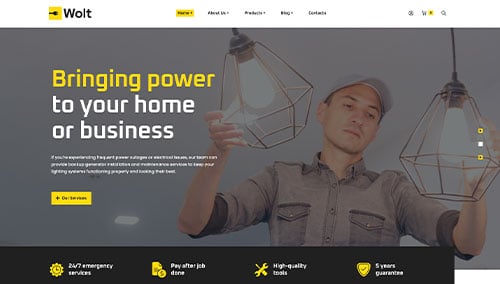
MrWatt – Themeforest
$34
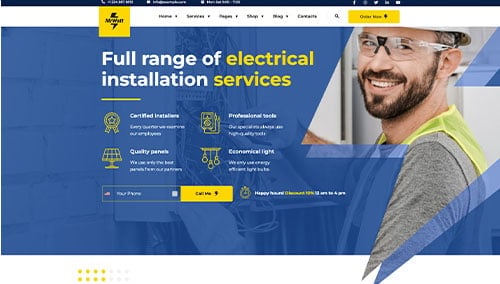
Electrician – Themeforest
$69
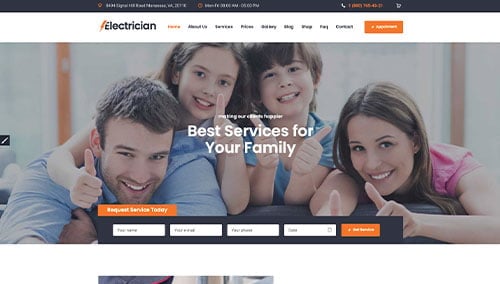
Windfall – Themeforest
$49
